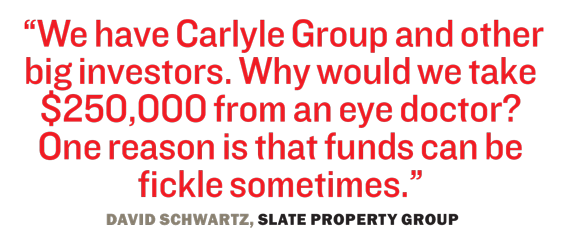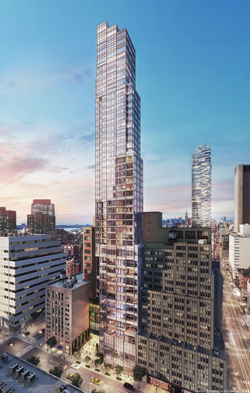
Back in 1980 — as oil prices were peaking in the aftermath of the Iranian Revolution — Israeli shipping magnate Sammy Ofer felt the itch to diversify his billion-dollar maritime empire.
Enlisting his then 30-year-old son, Eyal, as his proxy, Ofer waded into New York’s real estate market, paying $800,000 for a brownstone on 42nd Street near Fifth Avenue that he quickly flipped for $1.8 million.
Over the next three decades, the Ofers steadily expanded their core shipping business as well as their real estate investments in New York and across the United States. Since the early aughts, the family’s Global Holdings has backed marquee condos developed by the Zeckendorf family, including 15 Central Park West, 520 Park Avenue, 50 United Nations Plaza and 18 Gramercy Park, as well as the Rudin family’s Greenwich Lane, among other New York City properties.
But belying its large investments, the family always took second billing — if that — and has gone to great lengths to maintain anonymity. In 2007, Eyal Ofer reportedly lambasted the Times of London for printing his name in a list of the 10 richest families in the U.K., a claim he disputes. Nontheless, in a three-minute interview the following year with Israeli newspaper Ha’aretz, he said: “I have no good reason to stand out in front … I’m good at business, not at talking.”
Related: A snapshot of the quiet investors bankrolling NYC deals
But the Ofer family, which is reportedly worth billions — Forbes pegged Eyal’s net worth alone at $8.9 billion — is now stepping into a more visible role. In June, for example, Global Holdings made a splash when it went into contract to buy 1250 Broadway for $565 million. And sources say Global Holdings is preparing to expand its New York City office.
While it’s nearly impossible to quantify the pool of silent real estate investors, behind-the-scenes backers like Global Holdings have, of course, quietly funded New York developments and acquisitions for decades.
Simon Ziff, president of capital advisory firm Ackman-Ziff Real Estate Group, said these wealthy investors are highly sophisticated — even if developers simply see dollar signs.
“For nearly 30 years I have been asked to find the ‘dumb billionaire’ family office,” Ziff told The Real Deal. “Generally, successful family offices have access to the best intelligence.”
 Some of those players today include Israeli diamond magnate Beny Steinmetz, who sources said frequently bankrolls projects by HFZ Capital’s Ziel Feldman, and Morad Ghadamian, who regularly partners with developer Joseph Moinian and made his fortune importing rugs. The Cohen family, which founded Duane Reade, is also heavily invested in New York real estate as are the Gindis, who own the discount department store Century 21.
Some of those players today include Israeli diamond magnate Beny Steinmetz, who sources said frequently bankrolls projects by HFZ Capital’s Ziel Feldman, and Morad Ghadamian, who regularly partners with developer Joseph Moinian and made his fortune importing rugs. The Cohen family, which founded Duane Reade, is also heavily invested in New York real estate as are the Gindis, who own the discount department store Century 21.
Like Ofer, some of these deep-pocketed players have recently become more willing to reveal themselves.
In some cases, they’ve been forced into the spotlight as their appetite for investment has shifted from private equity to real estate, where they are seeing greater returns and are less shackled by strict investment timelines. The same goes for newly minted high-net-worth individuals who are more willing to be publicly identified if it means getting a bigger piece of the action.
“They tend to stay under the radar… but they’ve allocated more money to real estate as an asset class over the last 10 years,” said a consultant who works with a dozen ultra-wealthy families with New York real estate holdings. “The reality is that as they invest north of $100 million, things get out.”
Off the grid
To be sure, while many once-under-the-radar investors are showing their faces, there are still plenty of individuals who want to remain truly private, with their names rarely appearing on deeds, loans or other documents.
And in today’s market, many of them are writing the kinds of checks that developers lust after, particularly as traditional lenders tighten their purse strings.
Take Steinmetz. The frequent HFZ backer has a fortune worth an estimated $1.23 billion, but he’s best known for being the largest buyer of rough diamonds for the Luxembourg-headquartered diamond company De Beers and for his company’s controversial mining contracts in Africa.
Outside of Feldman, few know how much real estate BSG Capital Group — the investment arm of Steinmetz’s mining company — or other Steinmetz-controlled entities have backed. But Steinmetz’s presence at HFZ’s Midtown headquarters is so ubiquitous that he’s said to have his own (unofficial) office there, sources said. That could be a function of Steinmetz’s near-constant jet-setting. He has a home in Tel Aviv and a legal residence in Geneva, and his mining business is headquartered in London. Both Feldman and Steinmetz declined to comment, but in a rare interview with the Financial Times in 2012, the quiet mogul Steinmetz summed up the hard-charging style that’s led to his success. “You have to get your hands dirty,” he said.
And although he’s often described as tousled with movie-star looks, Steinmetz’s friend and the former Israeli Prime Minister Ehud Olmert told the New Yorker in 2013 that he shouldn’t be underestimated. Steinmetz, he said, is “the last guy you want as your enemy.”
 Similarly private is technology executive Arthur Becker — ex-husband to designer Vera Wang and former CEO of NaviSite, a web hosting company acquired by Time Warner Cable in 2011 for $230 million. He has quietly invested alongside JDS Development, Property Markets Group and Ambase Corporation at 111 West 57th Street, according to real estate research firm Real Capital Analytics. Becker’s Atlantic Associates LLC was a joint venture partner on the site’s acquisition and financing. In addition, Becker — who did not respond to a request for comment — has also backed PMG and Madison Equities’ condo development at 124 Sixth Avenue, a former carwash. Madison’s Robert Gladstone called Becker a “seasoned investor” who is also “one of the most delightful and interesting people you will ever meet.”
Similarly private is technology executive Arthur Becker — ex-husband to designer Vera Wang and former CEO of NaviSite, a web hosting company acquired by Time Warner Cable in 2011 for $230 million. He has quietly invested alongside JDS Development, Property Markets Group and Ambase Corporation at 111 West 57th Street, according to real estate research firm Real Capital Analytics. Becker’s Atlantic Associates LLC was a joint venture partner on the site’s acquisition and financing. In addition, Becker — who did not respond to a request for comment — has also backed PMG and Madison Equities’ condo development at 124 Sixth Avenue, a former carwash. Madison’s Robert Gladstone called Becker a “seasoned investor” who is also “one of the most delightful and interesting people you will ever meet.”
Yet there’s scant evidence of Becker’s other real estate investments and, for the most part, he (like other silent investors) has done his best to keep it that way.
With larger equity slugs, these financial backers want oversight in their investment but are rarely involved in daily operations, according to industry sources. “There’s always some sort of control built into their agreement. But for the most part, it’s passive,” said Ariel Property Advisors founding member Victor Sozio.
But even investors who want to remain anonymous are finding it increasingly difficult to do so, thanks to better online access to public records and companies that put massive amounts of data at users’ fingertips.
David Friedman, president of Wealth-X, which collects data on ultra-high-net-worth individuals, said that with the “proliferation of more open-source data” along with a global push toward transparency in reporting, it’s become harder for wealthy global citizens to stay anonymous.
But he added: “You still can’t cold-call these individuals even if you have identified them.”
Gaining a voice
While it’s nearly impossible to quantify the amount of private cash flowing into New York commercial real estate, cracks in the global economy have prompted wealthy players worldwide to turn to the sector as an investment vehicle.
That, of course, translates into a larger pool of behind-the-scenes partners that New York City developers can tap into, and it means silent backers are allocating more dollars to real estate than they have in the past.
Industry insiders told TRD the paradigm shifted during the financial crisis, when many ultra-wealthy families lost significant sums of cash because they were invested in seemingly sophisticated financial products saddled with risky underlying collateral. As a result, sources said, these investors grew increasingly eager to make direct investments.
“They don’t want to pay fees to someone to manage their money, they want to be directly involved,” said attorney Ed Mermelstein, who has represented several such investors.
While high-net-worth backers are clearly focused on preserving and growing their wealth, some also hope to wring tax benefits out of their investment, according to sources.
 For example, certain commercial properties are subject to tax breaks over time, and 1031 exchanges are a standard for investors looking to avoid — or limit — the amount of capital gains taxes they owe. In addition, some investors borrow (tax deferred) against their properties.
For example, certain commercial properties are subject to tax breaks over time, and 1031 exchanges are a standard for investors looking to avoid — or limit — the amount of capital gains taxes they owe. In addition, some investors borrow (tax deferred) against their properties.
For many investors, real estate has long been a way to leverage fortunes made in other industries and/or an opportunity to diversify their holdings.
For example, Harbor Group International’s Jordan Slone — now a well-known syndicator and investor with offices in New York and Virginia — made his fortune by starting a box spring manufacturing company, which he sold for an undisclosed amount in 1986. Today, Harbor’s real estate portfolio is worth an estimated $4.2 billion, according to the firm. Fast-forward to this past March and Harbor Group along with York Equities, an investor group led by Isaac Kassirer, dropped $140 million on a 38-building multifamily portfolio in the Bronx — the largest investment sale in the borough since 2013.
The burgeoning new population of wealthy (and often foreign) money has created a ripple effect of new opportunities throughout the industry.
The family-run mortgage brokerage Singer & Bassuk Organization, for example, has tapped into the trend by rolling out a “pledge” fund over the past year, aimed at connecting high-net-worth investors with the firm’s longtime developer clients.
“We’ve seen that people of means — who are not in real estate — have an overwhelming interest in taking a portion of their assets and getting into real estate,” said Singer & Bassuk’s president, Scott Singer. “For us, that’s created an opportunity.”
Large banks, including Credit Suisse and Deutsche Bank, have also launched digital platforms to connect high-net-worth clients. And members of ultra-wealthy families are personally attending networking conferences (instead of sending representatives) in order to sniff out investment opportunities, said Wealth-X’s Friedman, who’s organizing one such Manhattan meetup for 61 families in October.
Friedman and Singer both said some domestic families, which historically operated lean investment operations, are expanding their family offices to manage their portfolios and to attract more deals.
“Sometimes it’s about ego,” said Michael Weiser, president of GFI Realty Services, referring to investors who’ve stepped out of the shadows. “But more often than not it’s letting people know, ‘Hey, I’m here. I’ve got money to put out.’”
Similar to Global Holdings, the Cohen family, which founded the pharmacy chain Duane Reade, has invested quietly in real estate nationally for years through its Carlton Associates, run by David Cohen. (The family sold Duane Reade in 1992, and the chain had a series of owners before Walgreens scooped it up for a reported $1.1 billion in 2010.)

45 Park Place
While Carlton has written checks to Sitt Asset Management and real estate investment syndicator David Werner, who it shares a ground-lease stake with at 100 West 57th Street, the family began making headlines in 2012. That move into the spotlight came when a partnership between Werner, Carlton and real estate investor Joseph Mizrachi bought a 1.1 million-square-foot office tower in Chicago for $350 million — the highest price paid for a Downtown Windy City office building that year.
Today, Carlton has a stake in real estate valued at $2 billion, according to RCA. And sources close to the family said Carlton has invested $400 million in equity in New York real estate in the past four years. That sheer deal volume has made the family more visible.
In addition to 100 West 57th, it partnered with real estate private equity firm Savanna in Long Island City at One Court Square — the 1.5 million-square-foot office and retail building that Savanna acquired a controlling interest in back in 2014. (The purchase price was undisclosed, but the building traded for $500 million in 2011).
Meanwhile, Iranian-born Ghadamian frequently provides financing for Moinian, a fellow Persian Jew.
Ghadamian and his wife, Sima, a dealer in rare gems, moved to New York in 1978. From there, business savvy led to a lofty version of the American dream: In 2012, the couple paid $27.5 million for a co-op at 810 Fifth Avenue where Nelson Rockefeller once lived.
Ghadamian — whose son Daniel is a principal at real estate investment firm Capstone Equities — and Moinian are said to be “best friends” and can be spotted together at industry parties. The two men have also co-sponsored events at the Persian Jewish Center on the Upper East Side. Other than a handful of mentions in the real estate press, there is barely a trace of Ghadamian’s interest in Moinian’s projects. But that low profile began eroding last year when Ghadamian bought out Starwood Capital Group’s 49.9 percent interest in the Hilton Garden Inn on Central Park South, which Starwood and Moinian co-developed.
Both Moinian and Ghadamian declined to comment, but industry observers who are aware of their partnership say Ghadamian has invested millions in Moinian’s projects.
“Morad started with Joe early on,” said an industry source who’s worked with both men. “Now, he’s probably Joe’s biggest investor and has made a ton of money with Joe.”
Meanwhile, the Gindi family has also morphed from silent investor to active owner.
In 2014, the family company, led by CEO Raymond Gindi, sold off its 26-building portfolio (which is centered in Manhattan, Brooklyn and Queens) for $163.5 million. That year, the family’s investment arm, Gindi Capital, signed a long-term lease for 19,000 square feet at 19 West 34th Street, ostensibly to manage its liquid assets.
 Today the family has a stake in 32 assets with a total value of nearly $5 billion, according to RCA. The family has a stake in the Bryant Park Hotel, is partnered with Vornado Realty Trust at 650 Madison Avenue and is an investor in Silverstein Properties’ Silver Towers on West 42nd Street.
Today the family has a stake in 32 assets with a total value of nearly $5 billion, according to RCA. The family has a stake in the Bryant Park Hotel, is partnered with Vornado Realty Trust at 650 Madison Avenue and is an investor in Silverstein Properties’ Silver Towers on West 42nd Street.
Larry Silverstein told TRD he’s known the Gindi family for years, and that they developed a friendship before doing business together.
“One of the reasons we enjoy dealing with them is because we share core values — they are family-oriented people, we are family-oriented people,” he said.
The Gindis declined to comment, but they’ve undoubtedly established an enviable track record that others —including wealthy foreign investors — would like to emulate.
For foreigners with cash, providing quiet equity has been a good way to learn the real estate business before striking out on their own.
The most obvious (and well-documented) examples are Chinese investors, who last year poured $8.5 billion into U.S. real estate, 70 percent more than they spent in 2010, according to the Asia Society.
However, some foreign investors have provided funding to NYC projects with mixed results.
Al Waseet International — a Kuwaiti media company headed by Bashar Kiwan, a dual citizen of Syria and France — quietly backed Steve Witkoff’s $660 million purchase of the Park Lane Hotel in 2013, along with investors Harry Macklowe and Howard Lorber.
But in April, China’s Greenland Group bought out AWI’s 41 percent stake in the hotel. As part of the deal, AWI and Greenland formed a joint venture $8 billion real estate fund for global investment, signaling an end to AWI’s focus on New York, at least for now.
Neither AWI nor Greenland immediately commented, but Greenland said in a statement at the time of the buyout that the project could yield $3.6 billion to $4.3 billion in sales. “The real estate is unparalleled,” a source close to the development said. “Central Park South with the ability to build that tall of a building? That doesn’t just come along.”
The private sweet spot
Contrary to real estate lore, the notion of a developer making a single call to “his guy” and being handed an eight- or nine-figure check is rarely true. Even the Zeckendorfs had to convince Eyal Ofer to come on board in 2000, when they were trying to assemble the site for 520 Park Avenue.
At the time, Global Holdings owned a dilapidated brownstone on East 60th Street that was a missing piece to the developers’ land puzzle. After initially resisting the developers’ overtures, Ofer agreed to sell the land — in exchange for a stake in the condo project. The rest is history.
 Still, it’s far more common for developers to pass the hat among 40 investors who each chip in $1 million than to land a billionaire who is willing to stay silently out of the way. In addition, it’s not just major projects and big-time Manhattan developers like Zeckendorf, Moinian and Witkoff attracting low-profile financial backers. More often than not, it’s small- and medium-sized deals, according to brokers and developers.
Still, it’s far more common for developers to pass the hat among 40 investors who each chip in $1 million than to land a billionaire who is willing to stay silently out of the way. In addition, it’s not just major projects and big-time Manhattan developers like Zeckendorf, Moinian and Witkoff attracting low-profile financial backers. More often than not, it’s small- and medium-sized deals, according to brokers and developers.
Smaller projects, complicated deals and even up-and-coming developers are all sweet spots for wealthy investors who want to get into real estate, particularly since institutional backers are reluctant to put up money for those deals. Likewise, in the outer boroughs, banks and other lenders will write checks of a certain size very selectively.
In down (or even fluctuating) markets, private capital can also serve as a beacon to developers. In 2009 and 2010, when it was hard to get bank financing, Slate Property Group leaned on private investors, said principal David Schwartz. Then, between 2013 and 2015, the company tapped institutional capital. But so far in 2016, he said, the pendulum has swung back to private players.
Schwartz said working with private investors is a different ballgame and offers its own benefits.
“We have Carlyle Group and other big investors. Why would we take $250,000 from an eye doctor?” he said. “One reason is that funds can be fickle sometimes. They have investment committees that only allow them to invest when the market tells them to invest and not to when it doesn’t, whereas the individual investors are always there, through thick and thin.”
Silverstein also noted that there’s a stark difference between working with deep-pocketed families and institutional investors.
“Most institutional dealing is very specific, very defined,” he said. “There are certain things they can do, certain things they can’t do, certain things they have an appetite for, certain things they don’t have an appetite for.”
And private backing can mitigate developers’ risk amid rising land and constructions costs. GFI’s Weiser noted that with traditional lenders requiring more equity, the “absolute cash you need to do a deal is much more.”
“The entry point to a deal is up — $5 million five years ago is $10 million today — but the net operating income hasn’t risen that much.”
As a result, he said: “The smart owners are hesitant to lever up even if they can. You need the money who’s prepared to sit with you.”
Backer or developer?
As private investors take on more prominent roles in New York City acquisition and development deals, their precise roles are becoming murkier.
While in the past, many investors passively parked their money in deals, these days some investors have taken on co-developer roles. But the opposite can also be true, as active owners take a back seat in other deals.
Brooklyn investor Abraham Fruchthandler’s FBE Limited, for example, has provided equity to Ruby Schron’s Cammeby’s International over the years, and by most accounts FBE and Cammeby’s are co-developers on many Brooklyn multifamily deals.
But FBE — which has a stake in properties valued at $475 million, according to RCA — is also a quiet backer of Slate and Treetop Development, the firm headed by Azi Mandel and Adam Mermelstein. Fruchthandler and Treetop did not respond to requests for comment, while Slate declined to comment on the relationship.
Similarly, personal computing magnate Michael Dell’s MSD Capital also plays the dual role of backer and co-developer.
MSD owns a stake in 12 properties in Hawaii and New York that are valued at $3.5 billion, RCA data show. Even while acting as a shadow lender, MSD has been an active buyer in its own right.
In July, MSD shelled out $63 million for an unknown stake in Grand Central Terminal that the fund purchased from Lehman Brothers Holdings. (Lehman was part of an investor group that paid $76.5 million for the terminal in 2006. The now-defunct bank has been selling $639 billion in assets since filing for bankruptcy in 2008.)
And last year, MSD partnered with Adam America Real Estate on a 175-unit condo tower at 22-12 Jackson Avenue in Long Island City, which the duo paid $43.5 million for in a well-publicized transaction. By contrast, MSD’s stake in Sharif El-Gamal’s 45 Park Place condo — in which the firm holds a piece of the senior loan, according to sources — is extremely hush-hush. Both the developer and MSD declined to comment.
Nonetheless, while relationships may vary depending on the project, one thing is clear: There’s a palpable increase in the amount of interest among private players.
The abovementioned consultant to several ultra-wealthy families said that in the past few months he’s gotten calls from a number of clients who haven’t done a deal in 15 years but suddenly want to get back into the game.
“They’re saying, ‘We’ve got this money coming in, and we want to buy and get aggressive. We want to show people we’re looking to deploy capital,’” he said. “When you’re dealing with families, it’s all about preservation of capital and planning for the next generation.”
